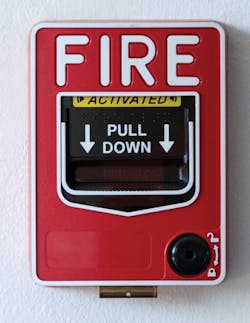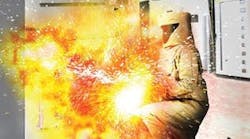Fire alarm systems serve a vital purpose. But if installed incorrectly, they can fail to protect building occupants. Worse, some errors can increase the danger to building occupants. Thus, Art. 760 (one of the NEC’s longest) provides extensively detailed installation requirements.
Art. 760 mostly covers installation limitations and requirements of the system conductors. These limitations and requirements haven’t changed much from the 2011 NEC; however, there are some notable exceptions:
- Installing PLFA cables in buildings. An entire new Section, 760.135, addresses the requirements. It’s slightly more than a full page.
- Various requirements for PLFA cables. Some changes were made to the many requirements. If you’re using PLFA cables, take the time to review all of the PLFA requirements.
- Requirements pertaining to circuit integrity (CI) cables. Some of the relevant Subsections have been extensively revised with the 2014 NEC. As with PLFA cables, take the time to review all of them.
Getting your bearings
Article 760 can seem overwhelming. You flip to it, and find page after page. Do you reach for that bottle of aspirin, or is there something else you can do to prevent a headache? Well, there is something else.
The good news is the bulk of what you need to read divides into two areas:
- Part II: Non-power limited fire alarm circuits (NPLFA).
- Part III: Power limited fire alarm circuits (PLFA).
The bad news is your fire alarm system design could consist of both kinds of circuits.
More good news is the general requirements (Part I) are short (barely more than a page).
Because Part IV provides listing requirements, if you specify only listed equipment you’ve got this one mostly covered — but not totally. There are four Tables you should review as work progresses:
- Table 760.154 [Applications of Listed PLFA Cables in Buildings]
- Table 760.154(A) [Cable Substitutions]
- Table 760.176(G) [NPLFA Cable Markings]
- Table 760.179(I) [Cable Markings]
General requirements
Confusion exists over whether the NEC covers a particular installation. Many building owners, motivated by short-term cost considerations, want to “short-spec” an installation by claiming some hair-splitting distinction excludes their application. When bidding a job as a contractor or performing the job as part of the in-house technical staff, use the Informational Note under the statement of scope [760.1] to win this dangerous game.
The other material in Part I consists of mostly reference and “common sense” references. An example is 760.24(A), which repeats the same requirements 110.12 provides about the mechanical execution of work. This is followed in 760.24(B), not by a general requirement, but by a specific requirement (for CI cable).
Non-power limited vs. power-limited
Whether a fire alarm circuit is power-limited depends upon its source:
- Power-limited (PLFA): The source is a listed PLFA or Class 3 transformer or power supply [760.121(A)]. Or if the equipment is listed and marked to identify the PLFA power source, then you have a power-limited circuit. An example of the latter is a fire alarm control panel with integral source [Informational Note under 760.121(A)].
- Non-power limited (NPLFA): The source complies with Chapters 1 through 5, and does not exceed 600V output [760.41]. Further, the source meets specific overcurrent protection requirements [760.43]. For conductors 14 AWG or larger, provide OCPDs per the conductor ampacity without applying the ampacity adjustment and correction factors from 310.15 to the ampacity calculation. For 16 AWG conductors, the OCPD can’t be larger than 10A; for 18 AWG, the limit is 7A.
These requirements aren’t totally different from each other. In either case, for example, the branch circuit(s) for the fire alarm equipment can serve no other loads [760.41(B) and 760.121(B)].
NPLFA
It might seem that the requirements for NPLFA circuits are more extensive than those for PLFA ones, but actually the opposite is true.
Where can you put the OCPDs for NPLFA circuits? You can install them at the point where the protected conductor receives its supply [760.45]. But there are three Exceptions and an Informational Note. The text is fairly extensive, but you should review it if your application makes this OCPD location difficult or impractical.
Class 1 and NPLFA conductors can occupy the same cable, enclosure, or raceway. It doesn’t matter if you have a mix of AC and DC, either [760.48(A)]. However, you can’t mix power supply and fire alarm circuit conductors in the same cable, enclosure, or raceway unless they connect to the same equipment [760.48(B)].
Any conductors you use in fire alarm systems must be copper [760.49(A)]. An exception exists for NPLFA; you can use Type PAF or PTS for high-temperature applications between 90°C and 250°C.
Conductors larger than 16 AWG must have enough ampacity per 310.15 for the intended loads. You can use 16 AWG or 18 AWG conductors, if they:
- Have the ampacity (per Table 402.5) to carry the loads.
- Are in a raceway, approved enclosure, or listed cable.
Any conductors must be rated at least 600V and, if larger than 16 AWG, comply with Art. 310. Conductors 16 AWG or 18 AWG must be one of the types listed in 760.49(B).
You can use multiconductor NPLFA cables if they meet the requirements of 760.176, are installed per the extensive 760.53 requirements, and operate at 150V or less [760.53].
PLFA
The branch circuit supplying the fire alarm equipment can’t supply other loads, and its OCPD must be permanently identified at the fire alarm control unit [760.121(B)]. Some other marking requirements apply to fire alarm circuits [760.121(B) and 760.124]; the idea is to eliminate confusion between these circuits and any others.
Wire the supply side of the power source per Chapters 1 through 4 [760.127]. On the load side, you can use the NPLFA methods of 760.46 [760.130(A)], the PLFA methods of 760.130(B), or a combination of the two [760.130].
The PLFA wiring method requirements include more than a page added with the 2014 NEC; these are application-specific requirements for various cable types [760.135]. Find your application; then see what’s required for the cable type you’re using.
Separation anxiety
The NEC is serious about keeping PLFA conductors separate from others. You can run two or more PLFA circuits in the same raceway, etc. [760.139], but as soon as you start to add other types of conductors, you run into restrictions. Anything other than specifically mentioned cables or conductors can’t be run with these, and audio system circuits are explicitly prohibited [760.139(D)].
There’s a laundry list of items (raceway, cable tray, enclosure, manhole, etc.) in which you can’t run these conductors with other conductors unless you use one (or more) of six methods of separation [760.136].
The barrier is one separation method [760.136]. Beyond barrier products, some manufacturers offer complete barrier systems. Since the engineering is done and field-proven, it seldom makes sense to try the “roll your own” approach.
You can separate these conductors from others by running them in their own raceway inside an enclosure [760.136]. The caveat is you’re separating these from NPLFA and medium-power network-powered broadband circuits. This method isn’t effective if you do something crazy like run these in an enclosure with 480V feeders.
One advantage of PLFA systems is you can use tiny conductors (as small as 26 AWG) [760.142]. But they must be spliced with a connector listed as suitable for 26 AWG to 24 AWG conductors and must terminate on equipment (or on larger conductors that terminate on equipment listed as suitable for 26 AWG conductors). Single conductors can’t be smaller than 18 AWG.
While 300.11(B) permits raceway to be used as a means of cable support under very limited conditions, common sense tells us not to support fire system cables that way. This is confirmed with a specific prohibition for PLFA cables [760.143] and is inherent in the requirements for NPLFA.
Listing and marking
Part IV of Art. 760 provides listing and marking requirements. This is primarily intended for cable manufacturers, but it’s a great reference for cross-checking the cable on that spool against the cable that the drawing or bill of materials calls for.
Substitutions
Samuel L. Jackson’s famous quip in the move Jackie Brown, “...accept no substitutes” doesn’t apply to fire alarm cables. You can make substitutions per Table 760.154(A) and Figure 760.154(A). Sometimes, the urgencies of a particular project can make substitution an attractive choice.
But that famous quip does apply to the requirements for installing those cables. Determine whether you’re working with NPLFA or PLFA, and follow the installation requirements for each. Don’t mix fire system cables with other wiring, and ensure they are clearly identified as fire system cables.
Lamendola is an electrical consultant located in Merriam, Kan. He can be reached at [email protected].





